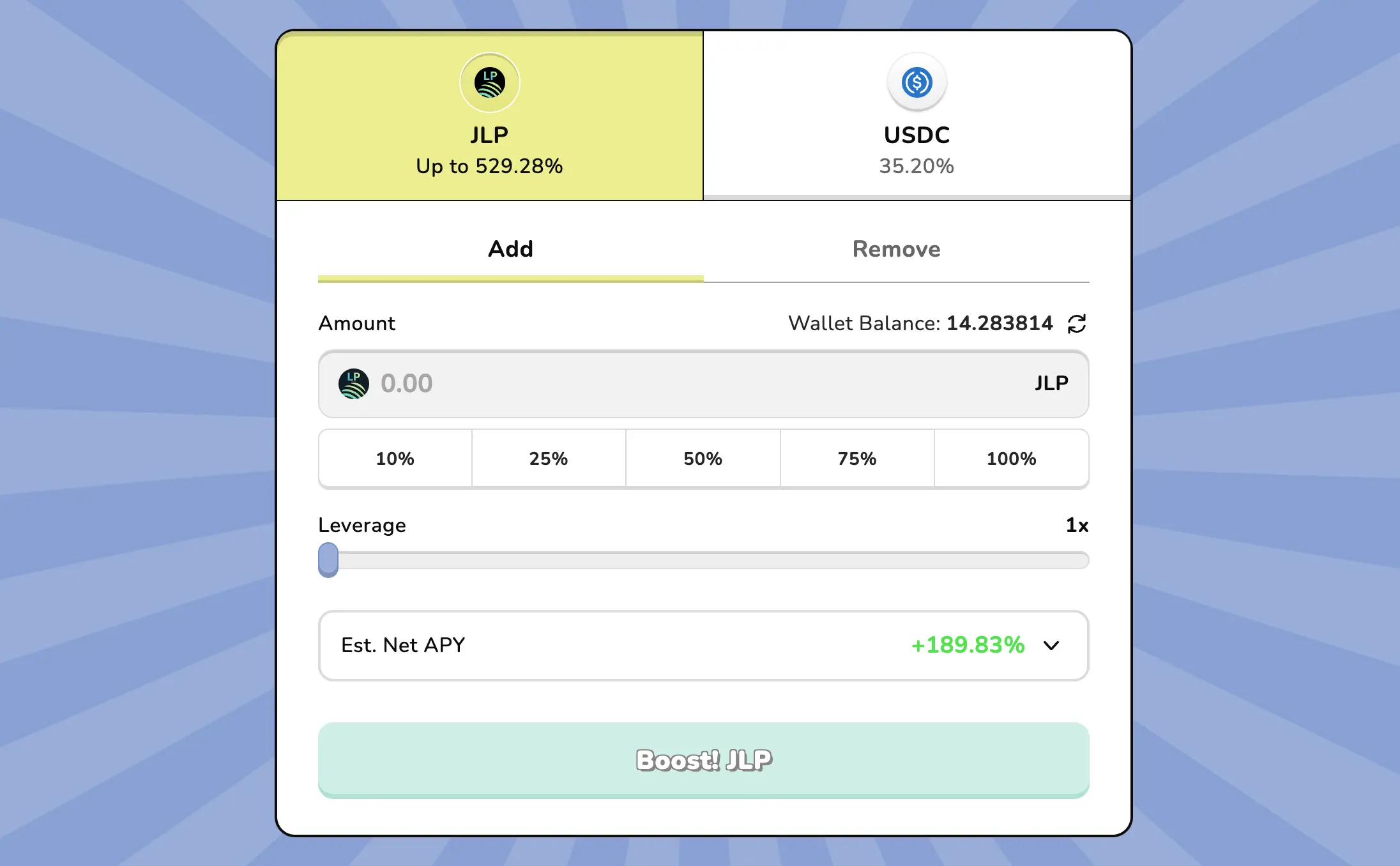Introducing Boost! v2
Boost! v2 is the easiest way to open a leveraged JLP (Jupiter Liquidity Provider) position to take advantage of the high native JLP yield. Simply deposit some JLP, select your leverage and boom, you've boosted your JLP.

Mango
Share post

Behind the scenes, your JLP tokens are used as collateral to borrow an amount of USDC (depending on your leverage). This USDC is then swapped to JLP, significantly increasing your exposure and potential JLP returns. The major upside is that no additional capital investment was required. Congratulations! You’re boosted.
However, this opportunity comes with its own set of risks, notably the potential for liquidation. Let’s wind it back to the basics for a refresher and track it through to Boost to ensure a good foundation for understanding this new Mango tool.
A refresher on JLP
JLP is part of the Jupiter Exchange ecosystem and serves as a liquidity provider token enabling traders to participate in Jupiter's perpetual markets. It's an SPL token and thus can be used in Solana DeFi like any other token.
JLP is entitled to 70% of the fees generated from perp trading on Jupiter. This fee-based revenue model directly reinvests earnings back into the JLP, facilitating its price appreciation and enabling a compounding effect on yields.
The JLP pool
The composition of the JLP pool includes a mix of both stable and non-stable tokens, roughly constituting 34% SOL, 10% ETH, 6% WBTC, 40% USDC, and 10% USDT. Holding JLP gives you freedom through exposure to an index of large crypto assets plus the added yield via fee generation. Win-win.
Getting JLP
The easiest way to get JLP tokens is by swapping on a DEX. On Mango, you can swap to JLP either via your wallet or Mango Account at the best prices (Mango swap routes through the top dexes on Solana to get the best price).
The other way to get JLP is by depositing assets (BTC, SOL etc) into the Jupiter Liquidity Provider Pool (JLP Pool), you'll receive JLP tokens in return, representing your share of the pool.
Up only?
Unfortunately not. The value of JLP is determined by complex dynamics and non-stable assets as part of the pool. It's a balance between the earning potential through operational exchange activities and the broader market performance of its underlying asset mix.
Boosting JLP
To get more exposure and native yield from JLP, you need more JLP. An incredible thought... Boost! v2 gives you the 'how'. The idea is to borrow USDC against your deposited JLP and then swap the borrowed USDC for JLP. This leaves you with more JLP than you deposited and a borrowed amount of USDC. As long as your borrow costs are less than the extra JLP yield, you'll make a profit.

Boost! v2 lets you easily add this leverage to your JLP position. It's made possible via a carefully managed risk framework by Mango DAO. The product's operational dynamics, including collateral fees and liquidation parameters, are designed to manage risks to the platform carefully.
The risks of boosting JLP
Adding leverage to any position comes with the risk of liquidation. Market volatility can quickly decrease the value of your collateral, which can lead to liquidation and the loss of some or all of your funds. If the value of JLP dips below your liquidation threshold, you guessed it... Liquidation.
Borrowing USDC also comes with costs. If the sum of these costs is greater than the extra yield from JLP then boosting becomes unprofitable. The fees and costs below should be considered before deciding to boost your JLP:
- USDC Borrow Rate - variable APR charged continuously on the balance of your USDC borrow and paid to USDC depositors (lenders) on Boost!.
- USDC Loan Origination - a one-time 50 basis points (0.5%) fee applied to the balance of your USDC borrow and paid to Mango DAO.
- JLP Collateral Fee - This is charged on your JLP collateral once every two days as insurance for JLP suffering a catastrophic failure resulting in bad debt. It will reduce the size of your JLP position over time. This fee accrues to Mango DAO.
- Position Entry Costs - When boosting USDC is swapped to JLP which can result in slippage.
To make a profit the extra yield from boosting needs to outweigh the costs of borrowing USDC.
There are other risks associated with using Boost! v2. The following in non-exhaustive:
- Use and reliance on 3rd party oracles
- Smart contracts could have bugs (they are audited by OtterSec)
- JLP could severely depeg
- An extreme market event could prevent exiting positions due to poor liquidity
- Boost! v2 UI could have bugs that prevent managing positions
Boosting USDC
The grass is always greener on the other side, right? Boosting USDC is straightforward, it's simply supplying USDC to the lending pool for JLP boosters. This allows your balance to be borrowed by traders looking to leverage their JLP.
When you boost USDC you earn interest on your loaned amount. The interest rate is variable and will fluctuate to reflect the current market demand for USDC loans within the lending pool. The dynamic nature of this interest rate opens your loan up to potentially higher returns compared to a fixed rate system.
One of the most appealing aspects of boosting USDC is the absence of fees. This is a pain-free option to get a return on your USDC. Celebrate with a Mango.
Are you boosted?
While Boost! v2 offers a compelling way to amplify your JLP exposure and potential returns, it comes with a high risk of liquidation and other associated costs. Consider the risks, consider your risk tolerance and consider the complex market dynamics before deciding to add any funds to Boost! v2.